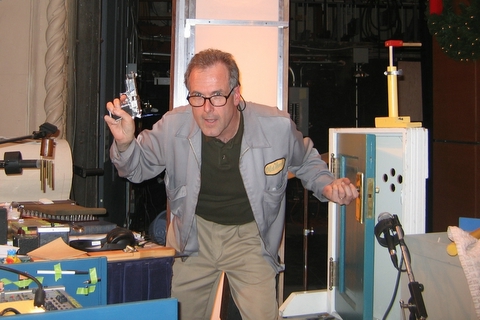
Tony at the door--with a gun. The classic SFX artist's pose.

Last updated: July 18, 2023

I learned my craft from sound effects artists that worked for Orson Welles, Jack Benny and other Golden Age (1930s-1960s) radio greats. In my live performances, recordings and workshops, I use a lot of manual sound effects, partly for the magic of making sounds through trickery and also I prefer the control of playing sound effects "instruments" over the electronic "sampler" keyboards that trigger sound effect recordings. (I DO use sophisticated electronic samplers and other playback devices for live radio-on-stage gigs. I used to host a website devoted to powerful and versatile Kurzweil samplers, but live SFX are more fun.
At workshops, I use manual sound effects because they preserve this golden age artistry. However, even in the old days, manual effects were not the only ones. Some sounds were cheaper and better produced as records, especially cars, planes, and weather and nature sounds.
A lot of the sound is how you manipulate the objects. You'll need to experiment to get just the right technique to produce the right sound. Also, test to see what your effects sound like over a microphone, something that sounds fine to your ears will come off as weak over a mike.
Useful tip: In the studio, I often use an omni-directional
microphone for sound effects--it picks up everything and adds a
nice ambience (room tone) to the sound, making it appear more real than if you held
the sound effect up to a regular uni-directional mike. And omni-directional mics makes life much
simpler when you have a crew of five to seven sound effects artists all vying
for the mic. See my page on engineering radio drama
for more tips on using microphones for sound effects. On stage, I use several
uni-directional mics.
Please keep in mind that radio drama is not merely a play with "lots of sound effects." A good radio play is good drama, full of conflict and even action, evoked through dialogue, music and sound effects, in that order.
Sound effects are an important ingredient, but by far, the least important. In radio, the dialogue and narration contribute roughly 75% to the drama, with music another 15% and sound effects a paltry 10%. Sound effects merely sketch in the action or punctuate dialogue and don' generally provide the precise reinforcement of reality in the way sets or locations do in plays and films. Sound effects suggest action, but they can easily be confusing or misinterpreted if relied upon too heavily.
Intrusive sound effects will make the dialogue harder for listeners to follow. Just the same, sound effects can turn a mere script into a real-time drama as opposed to just a story being recited.
Sound effects add realism, but should be used sparingly. In the production of radio drama, if a sound effect cue is missed, few listeners will notice. Use that as a guide and employ a minimum of sound effects. Only significant sounds are necessary. Sketch the scene, don't perfect it.
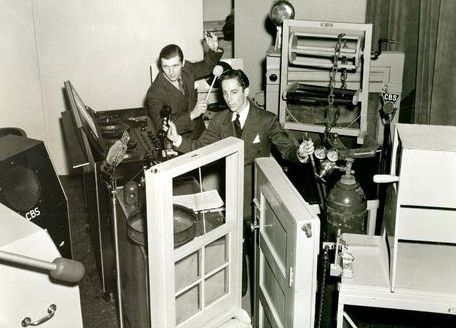
"Don't call it foley! We are sound effects artists!" That's what my mentor, Cliff Thorsness told me. Cliff was an ace sound effects artist at CBS's Hollywood radio studios from 1938-1962 and worked with Orson Welles, Norman Corwin, and on shows like Escape and Fibber McGee & Molly.
Radio sound effects artists are NOT the same as foley artists, who do film post-production sound work. Many people mistakenly use the term "foley" when describing radio sound effects. Whoops! While a doorknock sound is a doorknock sound, radio SFX artists do everything film foley artists do and a whole lot more. Radio SFX-perts have a broader skill-set, a larger sonic range, and a talent for multi-tasking. There's also a difference in union representation.
Radio sound effects artists handle every sound heard in a show--from footsteps to explosions to weather to exotic stuff like "walking on clouds." They produce these sounds either manually--handling objects and mechanical devices--or by playing back pre-recorded sounds--all in real time. They must coordinate with the actors delivering their dialogue and any live musicians throughout the radio play. During the Golden Age, most "sound men" were men. However, during World War II, women did take up the craft.
Please note that even back in the Golden Age, SFX artists also employed pre-recorded sounds (on 78RPM records) for car crashes, weather, ambiences, explosions--even crazy stuff like the famous "5000 drunken chickens." Not every sound was produced manually, but all were the responsibility of the sound effects artists--often 2 to 4, working simultaneously.
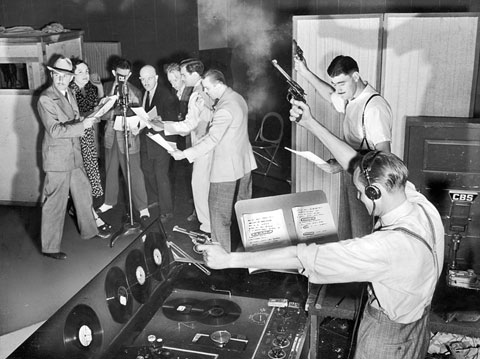
Above, you can see a two-man SFX crew. The front guy is shooting two blank guns while also manning a multi-turntable 'sound truck', used for playing pre-recorded SFX. Sound truck turntables would often have 2 tone-arms, to allow recorded tracks to effectively be "looped"--by cross-fading between two tone-arms tracking on the same record. They could also vary the speed--which could turn the recording of a waterfall into a nuclear bomb explosion. These were the "sample players" of the era.
Professional sound effects artists are members of the SAG/AFTRA union. They joined back in the 1940s when the union was still called AFRA (American Federation of Radio Artists--before television got unionized). I am a professional sound effects artist and veteran SAG/AFTRA member.
The term "foley" was coined in the 1980s for the
film industry's post-production re-recording of a small subset of sounds.
Foley usually deals
with human-generated sounds (footsteps, keys jangling, fist-fights, guns being cocked,
pouring water, etc.) These sounds are not done live by the foley artists while
the film actors do their dialogue and move about.
The reason for foley is that when a film is shot, only the dialogue is well-recorded (if that--due to
noisy locations). Mics on long booms are used to
pick up dialogue--mostly. During filming, when the actors take steps, slam doors, cock guns,
rustle papers, or jangle keys, those sounds aren't
well-mic'd because the sound sources are often further away from the boom mic
than are the actors' mouths. Film crews don't want mics
showing up in the
shot.

Later--after the film has been edited--the on-set sounds that were poorly recorded; the ones generated by human actions--are re-recorded, in sync with the edited visuals. In a recording studio, foley artists watch the edited movie on a screen and re-record the footsteps, keys, cocked guns (but not gunshots), pouring water, etc.--in sync with the actors' motions.
This kind of in-sync re-recording of sounds for film was pioneered by Jack Foley (1891-1967), a motion picture sound editor. In the 1980s, the M.P.S.E. (Motion Picture Sound Editors) union created a new job classification--"foley artist"--for tasks that had always been done by assistant film sound editors. These foley artists never did old time radio dramas and the foley sounds only a small subset of the total "soundscape" of a show--no horses, no cars, no wind, no thunder, no ticking clocks, no magical transformations. Foley is primarily footsteps.
This foley re-recording of sounds is done to reinforce a film's visual reality--what the audience sees on screen. If we see an actor dropping her car keys on the kitchen table, the re-recorded, foleyed sound of those keys makes that visual of the action seem believable. Without that keys-dropping sound--or if it was distant or too quiet--the audience would feel the scene was fake, even if we could hear the actor speaking her well-recorded lines.
Re-recording these few human-generated sounds is what foley artists do. It is pain-staking work. Foleying a filmed 40-second fight scene requires multiple passes of recordings and take 4 hours. Note that nowadays, many foley artists are women. It's easier for women to fake male footsteps than for guys to fit into high-heels and produce convincing female footsteps. If anything, women have an advantage in the foley business--and that goes for modern radio sound effects artistry too.
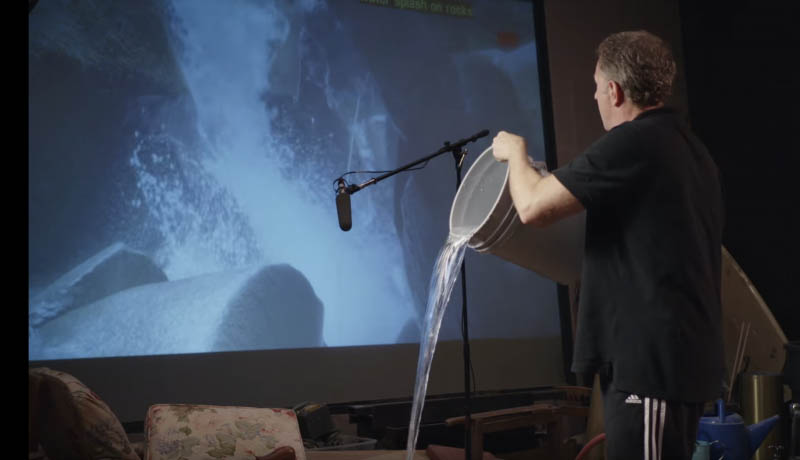
If you are interested in more information about foley, Philip Rodrigues Singer M.P.S.E., hosts a wonderful Art of Foley website devoted to this cousin of radio sound effects.
In film, beyond the foleyed sounds, all the other sounds--car crashes, gunshots, robot-tanks, stampedes, explosions, horses, even the destruction of planets--are handled by sound designers or sound editors, who employ recordings ("sampled sounds") or manipulate recorded sounds digitally. This kind of sound work is mostly done with computers. Professional foley artists, sound designers, and sound editors are members of M.P.S.E. They generally do not do radio plays, in-studio or recorded on-stage--which are under the jurisdiction of SAG/AFTRA.
In radio, the SFX effects artists do both the human-generated sounds that foley artists specialize in as well as as film sound designers' car crashes, gun shots, space ships, etc.--and we do it either by handling objects or mechanical devices (telephone ringers, wind machines, glass scratchers, creaker boxes, thunder drums, etc.)--or triggering pre-recorded sounds. So, "foley" is just a subset what a radio sound effects artist does.
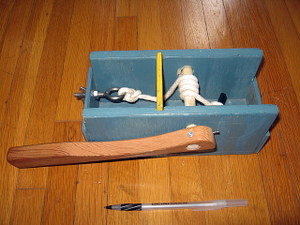
Years ago, I gave one of my radio-style creaker boxes (seen above) to the brilliant film sound designer, Ben Burtt (Star Wars, Indiana Jones, WALL-E). Ben flipped! He had never seen a device like this. In radio and film, little artistry or technology has been shared between the two mediums. My SFX mentors didn't go into film, despite the movie studios being just up the street. The radio networks frowned on letting movie studios ("the competition") gain any edge, so sharing technology or technique was forbidden. Of course, Golden Age network radio sound effects artists were so highly paid--with bigger salaries than radio actors--that working for the movies would have meant a pay cut!
Then there's the reality problem. Foley artists mostly work with the actual things that make the sounds they are emulating: shoes for shoes, chains for chains, guns for guns, plates, forks, leather jackets, etc. Foley artists don't "cheat" much--substituting one sound for another--with the notable exception of using carrots and celery for bones cracking. That's not the case with radio sound effects artists, we "cheat" all the time. My "gun cock" sound--an ice cream scoop--is more sonically convincing than the real thing. My radio SFX mentor, Cliff Thorsness, used wet wine corks rubbed on glass to fake the squeaking rats in the famous 1950 Escape episode, "Three Skeleton Key". Real rat squeaks weren't as nasty as what Cliff produced. In the world of radio sound effects, our motto is "Reality ain't what it's cracked up to be!" We pursue an expressive use of sound--by way of acoustic physics and "good ears."
On a philosophical level, radio SFX artists don't so much reinforce reality as evoke a reality--an imaginative world before your very ears! Unlike foley artists, we don't have to replicate everything seen by the audience. I suppose that cuts down on tedium, but also on billable hours--ulp! Radio SFX artists have to provide just enough sonic magic to conjure a setting or character's actions in the minds of our listeners. In effect, the radio SFX artist does all three film sound jobs--foley, sound design, and sound editing--and we do it all live, in real time.
However, we don't get three times the pay. Now don't that sound just awful?
So how far can you go with the illusion presented by sound effects in a radio drama? To illustrate the danger in relying too heavily on sound effects, I'll explain a failed comedy radio show I produced.
While experimenting with mic setups in the Museum of Television & Radio's production studio, we did a run-through of a script of The Lone Ranger, but the sound effects we had on-hand were from another show, Superman. Because this was just a mic test, we did part of the Lone Ranger with the wrong effects--ray guns instead of six shooters, cars instead of horses, etc.
It was hilarious! I thought I'd found a way to do comedy radio workshops for students--something notoriously hard to pull off because comedy requires timing and vocal inflection--which is difficult for amateurs, especially students. So, I decided to write a special script that used the "wrong sound effects" gag. Now, timing and inflection wouldn't matter--and it didn't.
I wrote a 1953-style soap opera, complete with all the typical soap sound effects of the era--baking cookies, pouring lemonade, the phone, the doorbell, etc. (Soaps were a dull gig for a sound effects artist--nothing much to do.)
As a plot device, the star of the show receives a mysterious voodoo doll, pricks her finger and faints. In a dream, she re-lives the previous scene, but now all the sound effects are wrong: dropping the cookie tray is the sound of a bomb dropping; the phone ring is a jackhammer; she answers the door and it's a train wreck, etc. What a brilliant, mind-tripping conceit!
Except the whole thing flopped! The kids doing the show didn't get it and the concept didn't work when we listened to it on playback.
I found that even setting up the scene with dialogue like "I'm expecting Sam's phone call..." SFX: jackhammer, "Oh, That's him now..." didn't "read" right. The audience merely accepted the jackhammer as some type of noisy phone sound.
On the "I Love Lucy" TV show, this kind of gag would have you in stitches, but without the visual disparity of image and wrong sound, this gag just didn't work in radio.
So, as much fun as sound effects are, don't over-rely on them. At some point they just get in the way and become noise. While the lack of visuals allows radio to do many things (plane crashes, medieval wars, prison breaks), it does impose some limitations too.